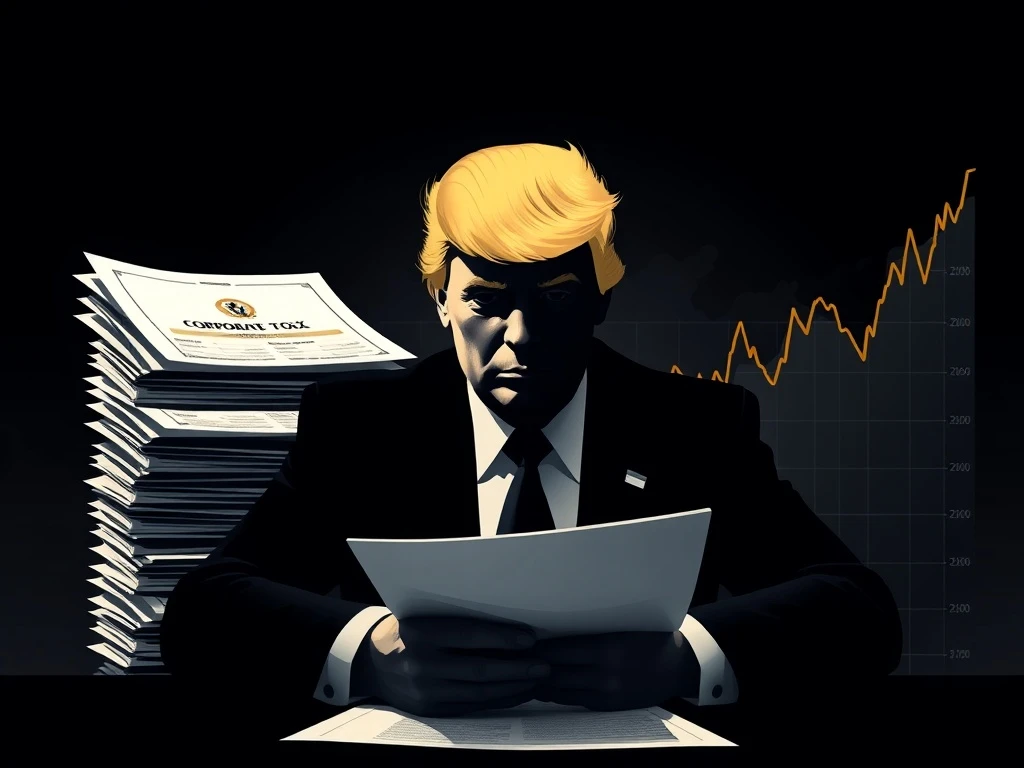For investors and business leaders, understanding economic policy is crucial. President Trump implemented a distinctive economic approach. This strategy significantly impacted corporate America. It subtly imposed costs on businesses. Interestingly, many observers describe these costs as a ‘tax’ in effect, even though they are not traditional levies. This article explores how Trump’s corporate tax policy, despite its unconventional nature, could profoundly reshape corporate America and influence stock market performance. We will examine the mechanisms at play and their potential ramifications for investors.
Understanding Trump’s Corporate Tax Policy: The Indirect Approach
President Trump’s economic strategy often focused on trade and regulatory actions. These measures aimed to shift corporate behavior. They effectively created financial burdens for businesses. These burdens functioned much like a tax. However, they bypassed the traditional legislative process for taxation. Therefore, they were not formally labeled as taxes. Instead, they manifested through various channels.
Firstly, tariffs became a primary tool. Tariffs are taxes on imported goods. They increase the cost for companies bringing products into the U.S. Consequently, businesses either absorb these costs or pass them to consumers. This directly impacts their profit margins. Furthermore, these tariffs often prompted retaliatory tariffs from other nations. This hurt American companies exporting goods. Ultimately, this created a dual pressure point for many corporations.
Secondly, trade negotiations played a vital role. The administration used the threat of tariffs or trade restrictions. This pushed companies to alter their supply chains. Many firms faced pressure to relocate manufacturing. They moved operations back to the United States. This relocation often involved significant upfront costs. It also increased ongoing operational expenses. Therefore, companies faced higher labor costs and different regulatory environments. This indirect cost acted as a levy on their global operations.
Finally, regulatory changes also contributed. The administration pursued deregulation in some sectors. However, it also increased scrutiny in others. For example, some industries faced heightened demands regarding domestic content or specific labor practices. These new requirements necessitated investments in compliance. They also added to operational overhead. This collective approach, rather than direct taxation, defined Trump’s corporate tax policy.
Direct Impacts on Corporate America and Profit Margins
These indirect measures had tangible effects on businesses. Companies across various sectors felt the pressure. Their operational costs often rose significantly. This directly impacted their bottom line. Therefore, understanding these impacts is crucial for investors.
Consider the manufacturing sector. Many manufacturers rely on global supply chains. Tariffs on steel and aluminum, for instance, raised input costs. Consequently, this eroded profit margins. Companies then faced a choice. They could absorb the costs. Alternatively, they could pass them on. Passing costs to consumers could reduce demand. Absorbing them would hit earnings. Both scenarios present challenges for corporate profitability. Furthermore, trade disputes created uncertainty. This made long-term planning difficult for businesses. They hesitated to make large capital investments.
Retailers also felt the strain. Many import goods from abroad. Tariffs on consumer products directly increased their purchasing costs. This led to higher prices for shoppers. Consequently, consumer spending could slow down. This impacts sales volumes and overall revenue. Businesses also had to re-evaluate their sourcing strategies. They explored new suppliers. They considered shifting production. Such changes are expensive and time-consuming. They also disrupt established networks. This directly affects efficiency and profitability.
Key impacts included:
- Increased Cost of Goods Sold (COGS): Tariffs directly raised the price of imported raw materials and finished goods.
- Supply Chain Disruptions: Companies scrambled to find alternative suppliers or relocate production, incurring significant logistical and setup costs.
- Reduced Investment: Uncertainty about future trade policies led many firms to delay or scale back expansion plans.
- Pressure on Pricing: Businesses faced difficult decisions regarding passing on higher costs to consumers, risking reduced demand.
These factors collectively squeezed corporate profit margins. They forced companies to adapt quickly. This adaptability often came at a financial cost. The indirect nature of Trump’s corporate tax policy meant these costs were sometimes less visible but equally impactful.
How Trump’s Corporate Tax Policy Influences Stock Market Dynamics
The stock market is sensitive to corporate profitability. Therefore, any policy affecting earnings will impact stock prices. Trump’s corporate tax policy, with its indirect costs, created notable shifts in market dynamics. Investors reacted to changes in corporate outlook. They adjusted their valuations accordingly.
Sector-specific impacts were particularly evident. Industries heavily reliant on imports, like consumer electronics or apparel, often saw their stock prices under pressure. Higher input costs meant lower projected earnings. This made their stocks less attractive. Conversely, some domestic industries, especially those competing with imports, might have seen a temporary benefit. They faced less foreign competition. However, even these gains were often offset by retaliatory tariffs. American exporters, for instance, faced new barriers in key international markets. This hurt their overseas sales and, consequently, their stock performance.
Investor sentiment also played a significant role. Trade tensions created market volatility. News of new tariffs or trade talks could cause rapid stock fluctuations. This uncertainty made investors cautious. They often favored companies with strong domestic focus. They also preferred those with diversified global supply chains. Predictability is highly valued in financial markets. The shifting nature of trade policy reduced this predictability. This led to increased risk premiums for many stocks.
Furthermore, the perceived long-term effects varied. Some analysts argued that domestic job creation would eventually outweigh the costs. Others warned of lasting damage to global trade relations. This divergence in opinion contributed to market indecision. It also led to different investment strategies. For example, some investors focused on large, resilient multinational corporations. These firms often had the resources to navigate complex trade environments. Other investors sought out smaller, domestically focused companies. They hoped these firms would be shielded from global trade wars. The influence of Trump’s corporate tax policy on market sentiment was undeniable.
Beyond the Obvious: Broader Economic Implications
The effects of Trump’s corporate tax policy extended beyond individual companies and stock prices. They rippled through the broader economy. These broader implications affected consumers and the overall economic landscape. Understanding these wider impacts provides a more complete picture.
Firstly, consumer prices often increased. As businesses faced higher costs, they frequently passed these expenses to consumers. This resulted in higher prices for various goods. Everything from washing machines to clothing saw price hikes. This effectively reduced consumer purchasing power. It also contributed to inflationary pressures. While the direct ‘tax’ was on corporations, the burden often shifted to households. This indirect taxation on consumers can dampen overall economic growth. It reduces discretionary spending, which is a key driver of the economy.
Secondly, global trade relations experienced significant strain. The aggressive use of tariffs and trade threats led to retaliatory measures from other countries. This escalated into trade disputes with major economic partners like China and the European Union. Such disputes disrupted established global supply chains. They also created uncertainty for international businesses. This friction complicated global economic cooperation. It also potentially hindered future growth opportunities for multinational corporations. The long-term impact on international trade structures remains a subject of ongoing analysis.
Thirdly, domestic competitiveness was a mixed bag. Some domestic industries saw a temporary boost from reduced foreign competition. However, this often came at the expense of higher input costs for other domestic industries. For example, a steel tariff might help domestic steel producers. Yet, it hurts U.S. manufacturers who use steel in their products. This created winners and losers within the domestic economy. The net effect on overall competitiveness is complex. It depends heavily on the specific industry and its reliance on global trade. Ultimately, Trump’s corporate tax policy aimed to rebalance trade, but its economic consequences were multifaceted.
Navigating Investment Strategies Amidst Evolving Corporate Tax Policy
For investors, understanding the nuances of Trump’s corporate tax policy is essential. It requires a strategic approach to portfolio management. The unpredictability of these indirect taxes demands careful consideration. Here are some strategies for navigating such an environment:
Firstly, focus on companies with strong balance sheets. Businesses with ample cash reserves and low debt are better equipped. They can absorb unexpected costs. They can also adapt to supply chain disruptions. Such financial resilience is key during periods of economic uncertainty. Look for companies that have demonstrated consistent profitability. They should also have robust cash flow generation. These traits indicate an ability to weather economic storms.
Secondly, diversify your portfolio across sectors. Some industries are more vulnerable to trade policies. Others are relatively insulated. For example, domestic service-oriented businesses might be less affected than global manufacturers. Spreading investments across different sectors can mitigate risk. It reduces exposure to any single policy shock. Consider a mix of large-cap, mid-cap, and small-cap companies. This provides broader market exposure.
Thirdly, pay close attention to company-specific guidance. Corporate earnings calls and financial reports offer valuable insights. Companies often discuss how policy changes affect their operations. They also outline their strategies for mitigation. This information can help investors make informed decisions. It provides a clearer picture of how individual firms are responding. Furthermore, monitor macroeconomic indicators. These include trade deficits, manufacturing data, and consumer confidence. These indicators offer clues about the overall economic environment. They help predict future policy directions. Adapting your investment strategy to the evolving nature of Trump’s corporate tax policy is a continuous process.
In conclusion, President Trump’s approach to economic policy introduced a novel form of corporate burden. These were not traditional taxes. Instead, they manifested through tariffs, trade pressures, and regulatory actions. This unique Trump’s corporate tax policy significantly impacted corporate America. It influenced profit margins, supply chains, and investment decisions. Consequently, the stock market experienced volatility. Sector-specific performance varied widely. Investors faced new challenges. They needed to adapt their strategies. The broader economic implications included higher consumer prices and strained global trade relations. While the direct intent was to rebalance trade, the ripple effects were profound. Understanding these indirect mechanisms remains vital for anyone navigating the complexities of modern economic policy and its financial market consequences.
Frequently Asked Questions (FAQs)
Q1: What is meant by ‘Trump’s corporate tax policy’ if it’s not a traditional tax?
A1: ‘Trump’s corporate tax policy’ refers to his administration’s economic measures that imposed costs on businesses without being formal taxes. These primarily included tariffs on imported goods, pressures to reshore manufacturing, and various regulatory actions. These measures increased operational expenses and affected profitability, acting like an indirect tax on corporations.
Q2: How did tariffs act as an indirect tax on companies?
A2: Tariffs are essentially taxes on imports. When the Trump administration imposed tariffs, companies importing goods (raw materials, components, or finished products) faced higher purchasing costs. This reduced their profit margins or forced them to raise prices for consumers, effectively taxing their operations or their customers.
Q3: Which sectors were most affected by this policy?
A3: Sectors heavily reliant on global supply chains and imports, such as manufacturing, retail, and technology, were significantly affected by increased costs due to tariffs. Conversely, some domestic industries competing with imports might have seen temporary benefits, though these were often offset by retaliatory tariffs impacting their export markets.
Q4: How did this policy impact stock market volatility?
A4: The unpredictability of trade negotiations and the imposition of tariffs created significant market uncertainty. News related to trade disputes often led to rapid fluctuations in stock prices. This increased volatility made investors cautious, leading them to adjust valuations and shift investments based on perceived risks and opportunities.
Q5: What should investors consider when analyzing companies under such policies?
A5: Investors should prioritize companies with strong balance sheets, diversified supply chains, and robust domestic operations. It’s also crucial to monitor company-specific guidance on how they manage trade and regulatory impacts, as well as broader macroeconomic indicators to anticipate policy shifts.
Q6: Did Trump’s corporate tax policy lead to higher consumer prices?
A6: Yes, in many cases. When businesses faced higher costs due to tariffs or other policy-induced expenses, they often passed these increased costs on to consumers through higher retail prices. This effectively acted as an indirect tax on households, reducing their purchasing power for various goods.








